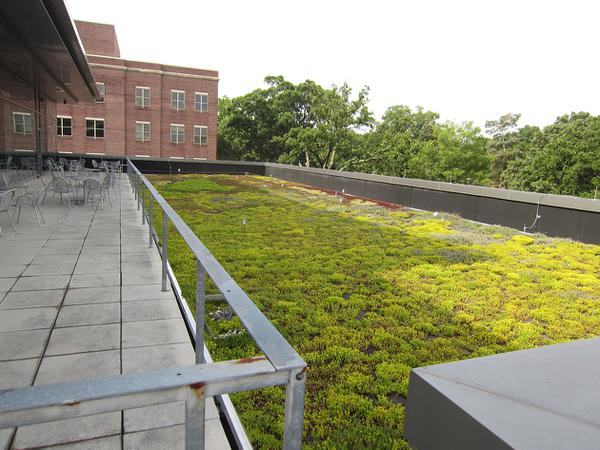By Amy Sechrist
Have you ever wondered how your physics class is heated? How the student union stays cool in the summer? Or even just what powers the lights in the library? These questions might not seem that interesting, but when you consider that a campus like the University of North Carolina at Chapel Hill has more than 175 buildings to heat, cool and power, these questions become vital for sustainability.

Amy Sechrist
It may not be as trendy as reusable bags, metal straws or other recent trends, but creating more sustainable energy systems has a huge impact on the environmental footprint at an institution like UNC. Thankfully UNC has acknowledged both ends of the sustainability spectrum with its development of the Three Zeros Initiative.
Amy Armbruster, Research and Outreach Manager for the Three Zero Initiative, describes the programs goals of net zero water, zero waster to landfills and net zero greenhouse gases as “huge, bold, ambitious goals,” but the program has already made progress towards all three since its launch in the fall of 2016.
But back to the question of how UNC heats, cools, and powers all of the buildings on campus. For the answer we turn to Adam Long, a Greenhouse Gas Specialist at UNC. During the Jan. 16 Natural Hazards Resilience Speaker Series event and tour of campus facilities, Long provided details about the systems that make UNC run smoothly.
The following discussion of UNC’s district energy system is based on Long’s talk as well as supplemental materials for further clarification.
UNC utilizes a district energy system to provide steam, chilled water and electricity to heat, cool and power its campus and UNC’s hospital complex. District energy systems are commonly used on college campuses as they provide an efficient method for heating and cooling many buildings from one central plant. Put another way, if UNC did not utilize a district energy system then each building on campus would need its own air conditioning unit and water heater, which would be much less efficient.
Beneath our feet every day, steam, chilled water and electricity run through 45 miles of steam pipe and 22 miles of chilled water pipe on campus. This system not only saves the University money, it is highly efficient and therefore more sustainable than alternative methods. Indeed, UNC’s district energy system has already reduced emissions with a 35% decrease in UNC’s greenhouse gas emission intensity (MTCO2e/gsf) since 2007.
According to Environmental and Energy Study Institute, district energy systems utilize a combined heat and power (CHP) plant as their central plant. The CHP puts the “waste heat” created in the electricity generation process to good use by repurposing it for heating and cooling. This cogeneration process, where electricity is a byproduct of making steam, creates about 15% of the electricity used on campus.
UNC began using a district energy system in 1939. After the main system of pipes was placed, whenever a new building was built, it could simply be connected to the original loop. Thankfully, the University recently invested heavily in this system, providing needed updates as well as additional features to increase efficiency.
Considering the growing need for more sustainable energy options to combat the climate crisis, why don’t all towns and cities utilize a district energy system? Many in the U.S. do; 837 systems are currently in place, usually in downtown areas, college campuses and hospitals.

An extensive green roof on the FedEx Global Education Center at the University of North Carolina at Chapel Hill is part of the campus’s sustainability initiatives. Photo by J. T. Sherk, North Carolina Cooperative Extension.
High efficiency, but a question of resiliency
The likely reason district energy systems are not more common is probably the cost. For example, for an existing town to convert to a district energy plan, they’d need huge upfront investments in the laying of pipe, building of the central plant and other necessary infrastructure. Despite the eventual cost savings, many towns are unable to pay such high initial costs.
But district energy systems also present a problem for resiliency. As extreme weather events become more frequent, our heating, cooling and electric systems must be built to limit outages, withstand extreme weather and keep us safe. Since district energy systems distribute from a central plant, if something were to happen to that plant, all buildings on the system would suffer lose access to electricity or hot water.
The way UNC deals with the need for both sustainability and resiliency in its energy systems is to build redundancy into their systems. UNC has two steam plants, four chilled water plants and three electric substations, in addition to the cogeneration facility and backup generators at key buildings. By creating multiple options for cooling, heating and electricity distribution UNC decreases the likelihood of a break in service during an emergency.
Armbruster, of the Three Zeros Initiative, laid out the connection between sustainability and resiliency, describing how increasing sustainability, also increases resiliency. By reducing greenhouse gas emissions, UNC is investing in a more sustainable future where we are more resilient because the we rely less heavily on fossil fuels for its heating, cooling and electrical needs.
More information on the Natural Hazards Resilience Speakers Series can be found on the Coastal Resilience Center website.
Amy Sechrist is a first-year master’s candidate in the Department of City and Regional Planning with a concentration in Housing and Community Development. Her research interests include affordable housing, planning for equity, and the intersection of gender and planning. Prior to UNC, she worked as a Housing Advocate and Shelter Manager at a gender-based violence crisis center and as a federal project management consultant. Amy holds a certificate in Creative Placemaking from the New Hampshire Institute of Art and a bachelor’s degree in Political Communication from George Washington University.
